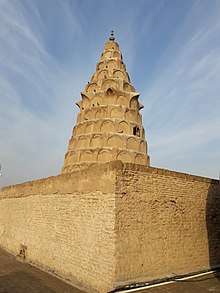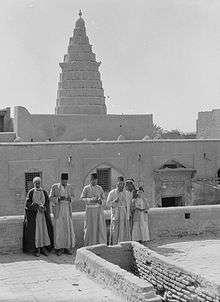Ezekiel's Tomb
Ezekiel's Tomb, located in Al Kifl, Iraq, is believed by Jews and Muslims to be the tomb of the biblical prophet Ezekiel. While the site is the oldest and most important Jewish religious site in Iraq,[1] it today it forms part of the Al-Nukhailah Mosque complex.[2]
| Ezekiel's Tomb | |
|---|---|
| Native names Arabic: قبر حزقيال Hebrew: קבר יחזקאל הנביא | |
 Conical dome of Ezekiel's Tomb | |
| Type | Mausoleum |
| Location | Al Kifl, Iraq |
| Coordinates | 32.22676°N 44.36716°E |
| Area | 54.06m2 |
| Height | 17m |
| Built | 12th-14th century |
| Built for | Ezekiel |
| Restored | 2012-2014 |
| Restored by | Imen-Sazeh Fadak Co. |
| Current use | Shrine |
| Architectural style(s) | Muqarnas |
| Governing body | Special Secretariat for the Shrine of the Prophet Dhel-Kifl and Annukhailiah Historical Mosque |
| Website | alnukhailah.iq |
 Location of Ezekiel's Tomb in Iraq | |
Description

According to the 8th-century rabbinical text Pirkei De-Rabbi Eliezer, Ezekiel was buried in Babylonia and mention of his tomb is first made by the 10th-century sage Sherira Gaon.[3] Ever since, Babylonian Jews were known to have visited the tomb and only in the 12th-century did Muslims begin to associate the site with a Koranic prophet.[3] Medieval explorer Petachiah reported in around 1180 that the Jews held the keys to the site and relates that between 60,000 to 80,000 Jews converged on the tomb during the week of Sukkot.[4] Benjamin of Tudela mentioned several synagogues at the location and noted that Muslim notables also frequented the site to pray.[5]
In 1860, the tomb became a source of contention when Muslims attempted to wrest control of the site. The British Consul in Baghdad attempted to resolve the issue of ownership and wrote that the Jews claimed that "the tomb has been in their possession for upwards of 2,000 years and that their right to it has never before been questioned".[6] Upon the intervention of the Anglo-Jewish Association, a government emissary from Constantinople decided in favor of the Jews.[7] At the turn of the 20th century, the Gazetteer of the Persian Gulf, Oman and Central Arabia stated that the tomb is "more venerated by Jews than it is by Muhammadans."[8]
Until the mid-20th century, over 5,000 Jews used to come to the tomb from Baghdad and other major cities during Passover.[9][10] During this period, the tomb walls contained various inscriptions including three poems honouring various donors. An adjoining room contained five tombs said to belong to five Geonim. Another room was referred to as "Elijah's Cave," and a third room contained the tombs belonging to the prominent Daniel family of Baghdad who were custodians of the site.[7] A Hebrew plaque above the doorway dating from 1810 read "this is the tomb of our master Yehezkel the Prophet, son of Buzi the Kohen, may his merit shield us and all Israel. Amen."[11]
After the fall of Saddam Hussein in 2003, the authorities redeveloped the tomb complex and converted the old synagogue courtyard into a Muslim prayer area. Some Jewish inscriptions from the tomb chamber were removed and replaced them with Koranic verses. The large new Al-Nukhailah Mosque currently encompasses the tomb structure,[12] Muslims believing the tomb to be that of an Islamic prophet Dhul-Kifl, often identified as Ezekiel.[3]
On the walls inside Hebrew script appears under a dome with medieval Islamic floral designs.
The site was protected under the control of Saddam Hussein.[13]
An additional structure also identified as a possible tomb for Ezekiel can be found in Dezful, Iran.
See also
References
- Joseph Shatzmiller (January 1, 1998). "Jews, Pilgrimage, and the Christian Cult of Saints: Benjamin of Tudela and His Contemporaries". In Walter A. Goffart (ed.). After Rome's Fall: Narrators and Sources of Early Medieval History: Essays Presented to Walter Goffart. University of Toronto Press. p. 345. ISBN 978-0-8020-0779-7.
Among the dozens of shrines shown to our travellers, one was outstanding in its privileged status – the shrine of the prophet Ezekiel. […] Although our reporters knew about other important shrines, it would seems that Ezekiel’s was the principle one.
- Honoring Jewish Refugees From Arab Lands: A Letter From a Forgotten Jew. Retrieved January 11, 2018.
- Aviva Schussman (November 1, 2002). "The Prophet Ezekiel in Islamic Literature". In Michael E. Stone; Theodore A. Bergren (eds.). Biblical Figures Outside the Bible. A&C Black. p. 330. ISBN 978-1-56338-411-0.
- Martin Jacobs (September 30, 2014). "Medieval Mingling at Holy Tombs". Reorienting the East: Jewish Travelers to the Medieval Muslim World. University of Pennsylvania Press. p. 120. ISBN 978-0-8122-4622-3.
- The Holy Bible: According to the Authorized Version, Containing the Old and New Testaments : with Original Notes, and Pictorial Illustrations. C. Knight. 1838. pp. 209–210.
- Peter C. Craigie (January 1, 1983). Ezekiel. Westminster John Knox Press. p. 4. ISBN 978-0-664-24574-0.
- Cecil Roth (1972). Encyclopaedia Judaica: A-Z. Encyclopaedia Judaica. p. 1097.
- J. G. Lorimer (2003). Gazetteer of the Persian Gulf, Oman and Central Arabia. Archive Editions. p. 2368. ISBN 978-1-85207-030-4.
- David M. Gitlitz & Linda Kay Davidson ‘’Pilgrimage and the Jews’’ (Westport: CT: Praeger, 2006) 96–97.
- Passover pilgrimage to Ezekiel's tomb in Iraq
- Sassoon, David Solomon (2002). "The Sassoons' Return Visit to Baghdad". The Scribe. Autumn 2002 (75). Retrieved May 18, 2020.
- Zvi Yehuda (August 28, 2017). "Struggle of Iraqi Jewry for Control of Prophet Ezekiel's Tomb". The New Babylonian Diaspora: The Rise and Fall of the Jewish Community in Iraq, 16th-20th Centuries C.E. BRILL. pp. 188–189. ISBN 978-90-04-35401-2.
- Iraq launches project to renovate Ezekiel's shrine
External links
- Ancient Holy Site Faces Modernization – slideshow by The New York Times
- Unique Pictures Of The Ancient Torah Ark Inside The Ezekiel Shrine By Kobi Arami
- Unique Pictures Of Inside The Ezekiel Shrine Rooms By Kobi Arami
- Unique Pictures Of The Ancient Synagogue At The Ezekiel Shrine By Kobi Arami
- Unique Pictures Of The Five Tombs Of Geonim(were the presidents of the two great Babylonian, Talmudic Academies of Sura and Pumbedita) Room At The Ezekiel Prophet Shrine By Kobi Arami
- Unesco.org - The Site of Thilkifl
- Babylon's forgotten tomb, a symbol of Iraq's ancient Jewish heritage
- Jewish Shrine of Prophet Ezekiel’s Tomb Open to Visitors in Iraq's Shi'ite Heartland